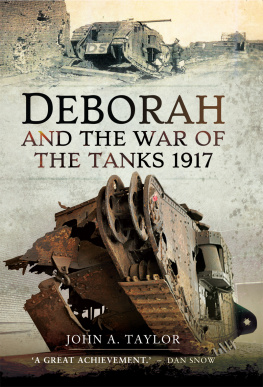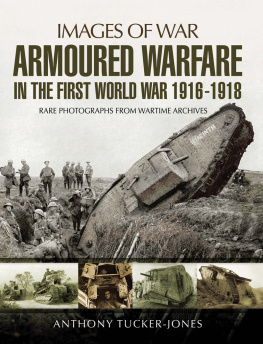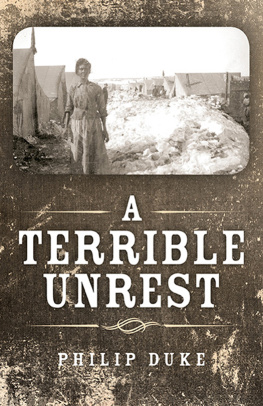

To my wife Kim
Who joined me on this journey
Contents
List of Plates
List of Maps

Acknowledgments
T his book tells the story of D51 Deborah , a First World War tank which returned from the grave and is now preserved in France as a memorial to the men who fought in her. The task of discovering and preserving Deborah was led by Philippe Gorczynski, an authority on the Battle of Cambrai who combines his passion for history with the business of running a hotel in the town. In the subsequent project to unearth her human and military history, he has been supported by a small and equally passionate group of enthusiasts based in the UK.
This book therefore represents the fruits of nine years research by a dedicated team that includes Vince McGarry, a tireless investigator whose journalistic skills have enabled us to track down a large number of families connected with D and E Battalions of the Tank Corps, and who provided invaluable support in the preparation of this book; Rob Kirk, another ex-journalist who originally brought the team together and has acted as co-ordinator and master of ceremonies for the project; and Alan Hawkins, a genealogist whose expertise at untangling family trees has proved crucial in our research. Their wives Sandrine Gorczynski, Karen McGarry, Elaine Kirk and Margaret Hawkins, and my own wife Kim Badland, have also been active and enthusiastic supporters of the project from the start.
As well as these core members of Team Deborah, many others have provided support, notably David Fletcher, Stuart Wheeler, Janice Tait and their colleagues at the Tank Museum in Bovington; Geoffrey Vesey Holt, the historian of the Royal Tank Regiment; and Johan and Luc Vanbeselaere, Dirk Vinck and their friends based in Poelkapelle in Belgium. Special thanks are also due to Lieutenant-Colonel Stephen May and Colonel John Longman for permission to reproduce a painting by Sergeant Claude Rowberry owned by the Royal Tank Regiment; to Dan Snow for his great support; to Jean Luc Caudron for permission to include his photograph of Deborah in German hands; to Iona Murray, an archaeologist at Historic Scotland who passed on vital eyewitness evidence from her great-grandfather; to Rosemary ONeill at Christchurch City Libraries; to historians Gareth Davies, Gwyn Evans, Jean-Luc Gibot, Nigel Henderson, Nigel Jones and Stephen Pope who have generously shared their advice and research; and to Heidi Adler-Schrade, Norbert Schnitzler and Carina Syring for their help with the German translations.
In addition, we have relied on the information and support provided by members of more than 100 families whose ancestors fought in the tanks of D and E Battalions, or were otherwise involved in the Battles of Passchendaele and Cambrai, notably Mary Baker-Carr and Tony Rundell; Julian and Nicola Bion; Roderick and David Bullock; Jim Christie; Paddy Clark; Dr Mary Coghlan and Noel Coghlan; Canon Ian Cohen; Sylvia and Stephanie Collinson-Cooper; Jenny and John Dodd; Brigadier Ben Edwards OBE; Russell and Etheline Enoch; Charles Foot; Stewart Galway; Chris and Mike Head; Will, Peter, Tim, Paul and John Heap; Rob and Sue Henshall; Deborah Howard; Derek Leland; Charles and Ken Macdonald; John Macintosh; Ian MacNiven and Peggy L. Fox; David Melliar-Smith and Deborah Palmer; Sue Peck; Anna Petrou; Alison and Catherine Piper; Corinna Robertson; Joyce and Bob Robinson; Paul Russell; Jean Smith; Doris and John Summers; Mike Tipping; Peggie Trei; Basil Vose; Simon Ward; William and Helena Watson; Ted Wenger; Derek White; Jim Yates; and others too numerous to thank by name.
Despite the involvement and support of so many people, the opinions and interpretations in this book are mine alone, and I take full responsibility for them, and for any errors that may have occurred.
In terms of written records, we have drawn on the rich resources of the National Archives in Kew, and many other collections including the Tank Museum, the Imperial War Museum, the National Army Museum, the Liddell Hart Centre for Military Archives, the Liddle Collection, the London Library and the British Library, as well as the archives of various regiments, sports clubs, schools and colleges. In France we have drawn on the collection of Philippe Gorczynski, the archives of the Historial de la Grande Guerre at Pronne, and the letters owned by Mme Bacquet in Cambrai; and in Germany, on the official holdings of the Militrarchiv at Freiburg im Breisgau and the Hauptstaatsarchiv in Stuttgart. The Great War Forum and Landships Forum have provided a constant source of knowledge and expertise.
The final key component in our research has been the largest, but largely hidden, archive of Great War material, namely the documents, photographs, artefacts and memories preserved by the many families who we have contacted, and which they have shared freely and selflessly with us.
This book is therefore a testament to the knowledge and skills of a large number of people, and to the enduring power of Deborah as a unique relic of a war that continues to haunt our memories and imaginations.
Foreword
Tank commanders impressions of the attack at Cambrai, 20 November 1917
Action stations. Everyone inside driver and officer side by side, front flaps half open four gunners standing by, closed down infantry runner sitting on oil container with back to officer [carrier] pigeons in basket stowed under one sponson [i.e. gun housing on side of tank].
Engine hot, probably been running for some hours; most engines run better once they have boiled, very difficult to guarantee engine would restart if stopped. Not advisable to throttle down too much as sheets of red flame crack out of exhaust pipe or through joints in pipe on roof. If engine kept running too fast exhaust pipes glow red.
Once doors closed tank almost in darkness similar to overhead yellow London fog four festoon lamps illuminate interior dimly used sparingly as visible from outside. Rear door left ajar as long as possible.
Zero hour: comparative silence broken quite suddenly by crash of guns fired simultaneously, whistle and whine of shells overhead, a pause whole of far side of No Mans Land lit up in dawn light smoke everywhere company commander comes to front and shouts signal to start.
Driver hammers one side of engine casing, holds up one finger, gearsman gets first gear, officer hammers other side, same procedure, tank lurches forward.
Other tanks dimly seen on left and right going good occasional shell-hole has to be crossed, each time tanks nose dips ammunition boxes, odd tools, etc. slide forward and then backwards with metallic crashes. Gearsmen and gunners hang on. Inside of tank getting hotter. Harsh tapping outside tank indicates hostile M.G. [i.e. machine-gun] fire.
Black mass three feet high and as far as the eye can see appears in growing light German wire. Tank goes up to it looks terribly formidable will it catch in tracks and wind round and round tank turning it into a cocoon, or will it spring up behind again and prevent infantry following? Glance through back shows broad lane through wire along which packets of infantry are following. Second belt rather less thick front flaps opened to facilitate driving.
Sudden tapping on port side of tank gunner holds hand up, cut in many places with splash and flake [i.e. flying fragments of metal caused by bullets hitting tank]. Burst of M.G. fire had hit tank at spot where sponson turret joins tank and had ripped away felt packing, hitting gunner in hand tank swung 10 degrees all ports closed down.
Next page



















